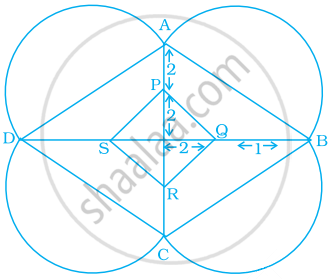Advertisements
Advertisements
प्रश्न
The given figure shows a rhombus ABCD in which angle BCD = 80°. Find angles x and y.

उत्तर
In rhombus ABCD, diagonals AC and BD bisect each other at 90°
∠BCD = 80°
Diagonals bisect the opposite angles also ∠BCD =
∠BAD (Opposite angles of rhombus)
∠BAD = 80° and ∠ABC = ∠ADC = 180° – 80° = 100°
Diagonals bisect opposite angles
∠OCB or ∠PCB =`80^circ/2` = 40°
In ∆PCM,
Ext. CPD = ∠OCB + ∠PMC
110° = 40° + x
⇒ x = 110° – 40° = 70°
and ∠ADO = `1/2` ∠ADC = `1/2 xx 100^circ = 50^circ`
Hence x = 70° and y = 50°
APPEARS IN
संबंधित प्रश्न
Points E and F lie on diagonal AC of a parallelogram ABCD such that AE = CF. What type of quadrilateral is BFDE?
In a parallelogram ABCD, AB = 10 cm, AD = 6 cm. The bisector of ∠A meets DC in E, AEand BC produced meet at F. Find te length CF.
Which of the following statement is true for a rhombus?
It has only two pairs of equal sides.
Which of the following statement is true for a rhombus?
It has all its sides of equal lengths.
Fill in the blank, inthe following, so as to make the statement true:
A rhombus has all its sides of ...... length.
One side of a rhombus is of length 4 cm and the length of an altitude is 3.2 cm. Draw the rhombus.
Diagonals PR and QS of a rhombus PQRS are 20 cm and 48 cm respectively. Find the length of side PQ.
A Rangoli has been drawn on a flor of a house. ABCD and PQRS both are in the shape of a rhombus. Find the radius of semicircle drawn on each side of rhombus ABCD.

Construct a rhombus whose side is 5 cm and one angle is of 60°.
Construct a rhombus CLUE in which CL = 7.5 cm and LE = 6 cm.
